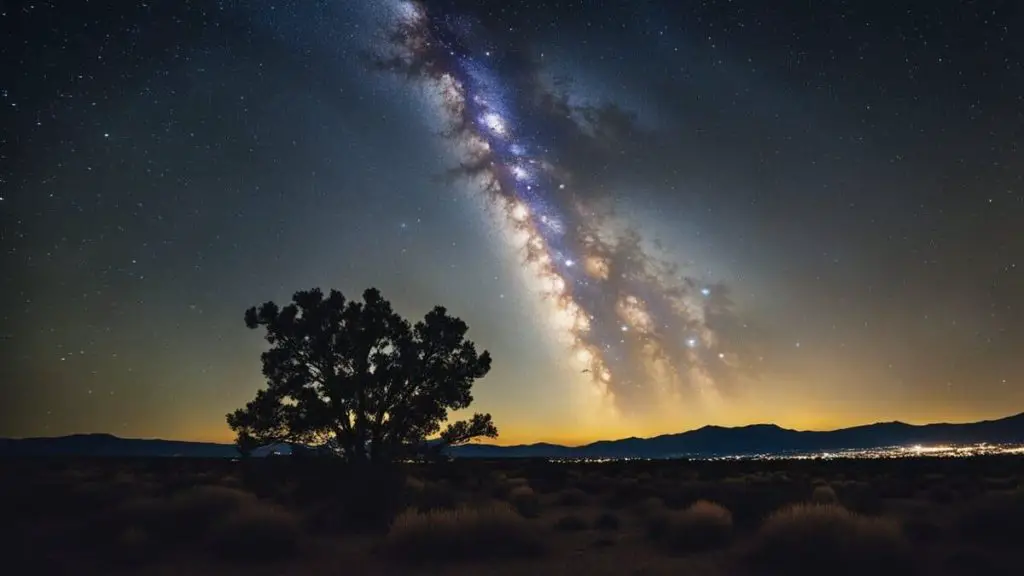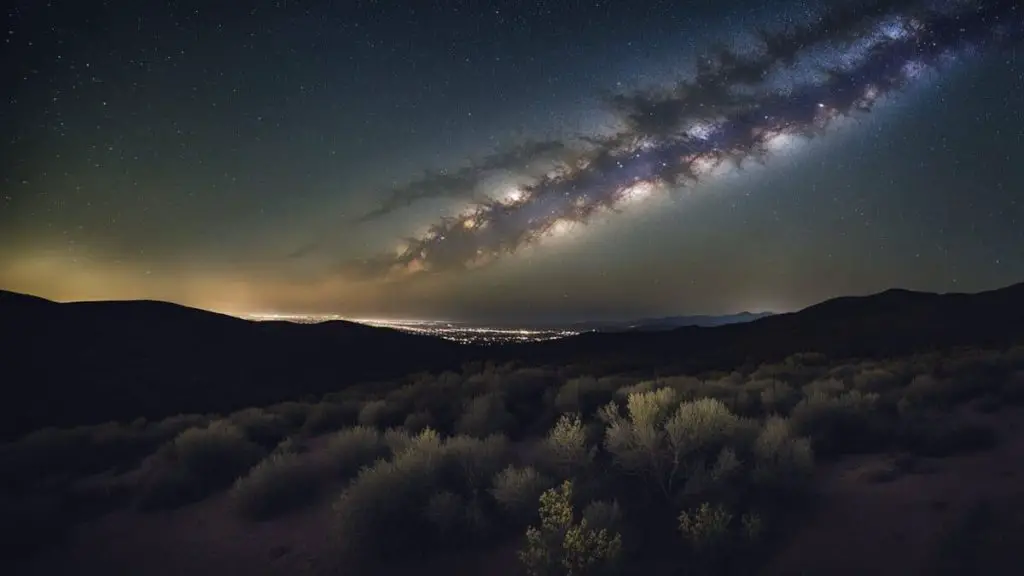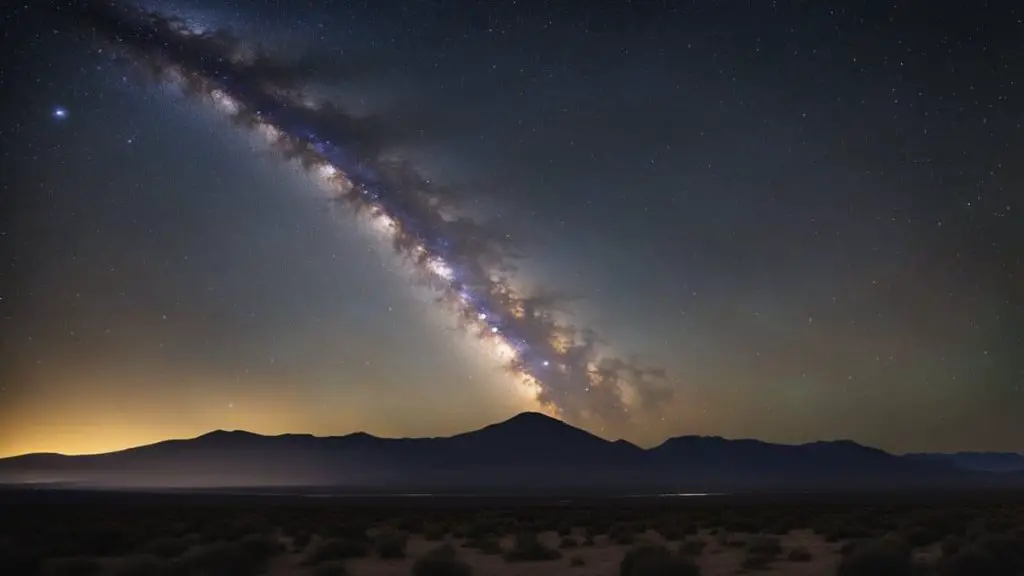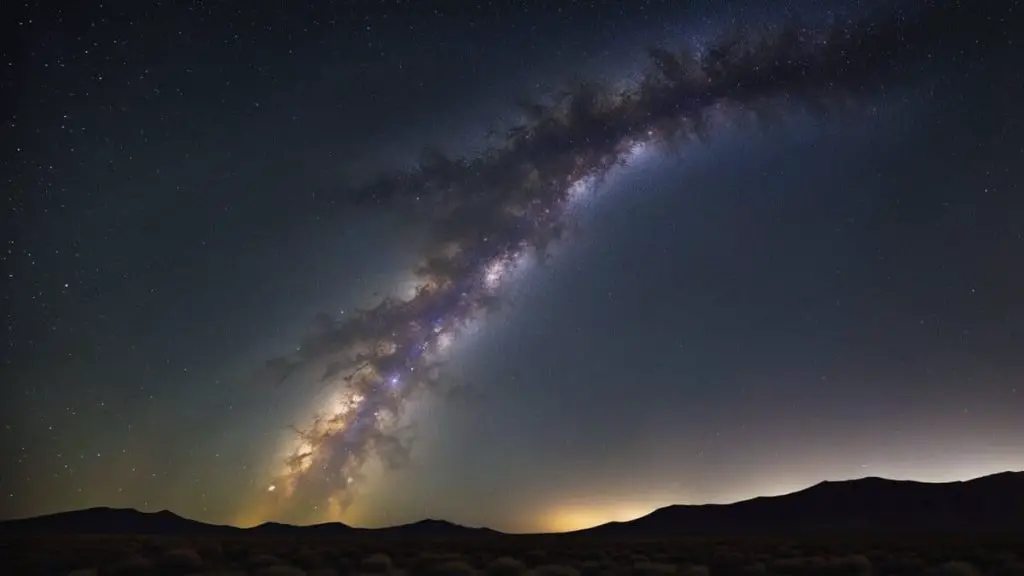Imagine standing under New Mexico’s vast sky, eager to witness the Milky Way’s celestial dance. This majestic sight promises an unforgettable experience as you look upon the galaxy where Earth resides.
But finding the right time and place to see the Milky Way clearly is tricky. Light pollution, moon phases, and understanding the galaxy’s position can all cloud your stargazing plans.
I’ve crafted this comprehensive guide to help. Here, you’ll learn when and where to enjoy the Milky Way’s splendor in New Mexico in 2024. Whether you’re a seasoned stargazer or a curious beginner, the wonders of our galaxy await you.
When can you see the Milky Way in New Mexico?
To catch the Milky Way Galactic Core in New Mexico, plan for a dark, clear night, typically from April to August. The galaxy’s vibrant center is visible for four or more hours during this Milky Way Season.
Recommended For You
Understanding the Milky Way

The Milky Way is our galaxy, home to billions of stars, including the Sun. It’s a spiral galaxy, which means it has a central core and curved arms extending outwards. When I’m in a dark place free of light pollution, I can see a dazzling band of light strewn across the sky. That’s our view of the Milky Way!
When can you see the Milky Way in New Mexico?

One of the best times to see the Milky Way in New Mexico is during the summer months. If summer doesn’t work for you, don’t worry! The Milky Way can also be seen in the spring and fall, which I’ve found true through many nights spent under the stars.
As you can see below, the Milky Way galactic center is visible nearly every month, but only during certain hours. So, when is Milky Way Season in New Mexico?
The best months are April to August, when the Milky Way core is visible for four or more hours.
Here are the Milky Way Galactic Center rise and set times for the middle of each month in New Mexico.
Best times to see the Milky Way in New Mexico
- January 5:38 am – 5:44 am
- February 3:35 am – 5:26 am
- March 2:42 am – 5:50 am
- April 0:40 am – 5:02 am
- May 10:42 pm – 4:20 am
- June 10:09 pm – 4:03 am
- July 10:03 pm – 3:44 am
- August 9:26 pm – 1:42 am
- September 8:37 pm – 11:40 pm
- October 7:54 pm – 9:42 pm
- November 6:27 pm – 6:40 pm
- December not visible
To increase your chances of seeing the galaxy, plan your stargazing around the moon’s phases.
A new moon, or a moon just a few days away from being new, will provide you with the darkest skies possible. On the other hand, a full moon might hinder your view, with bright moonlight washing out the stars.
Here are some tips for the best Milky Way viewing experience:
- Choose a night with minimal moonlight, such as a new moon or a few days before or after.
- Avoid any light pollution by venturing away from city lights, which can make it difficult to spot the Milky Way.
- I’ve learned to be patient as my eyes adjust to the darkness for about 20 minutes before I start stargazing.
- Bring binoculars or a telescope to enhance your view of the night sky.
Seeing the Milky Way in New Mexico

New Mexico has provided me with some fantastic stargazing opportunities. I cherish these moments when the galaxy seems close enough to touch.
One of the prime locations to see the Milky Way in New Mexico is Ghost Ranch. Ghost Ranch, with its striking red and yellow cliffs, is as captivating at night as it is during the day.
My wife and I visited Ghost Ranch a few years ago during our adventure through New Mexico. I captured this amazing image of the Milky Way over our RV.
The landscapes that inspired Georgia O’Keeffe offer dramatic views under starlight. The ranch offers night programs that include stargazing sessions. During the day, enjoy workshops, horseback riding, and hiking before settling down for stargazing. Then, watch as the Milky Way transitions overhead and towards the west-southwest throughout the night.
Here’s a quick list of other fantastic places in New Mexico for observing the Milky Way:
- El Malpais National Monument: A stunning lava field that provides open and dark skies.
- Chaco Culture National Historical Park: This ancient site offers dark skies and cultural history.
- Cosmic Campground: Situated in the Gila National Forest, this remote and peaceful spot is perfect for stargazers.
- Aztec Ruins National Monument: Ancient ruins and a dark sky make this a tremendous stargazing destination.
- Capulin Volcano National Monument: As a Gold-Tier International Dark Sky Park, the views from this extinct volcano are unmatched.
For a complete list, read my dedicated article on the best stargazing in New Mexico. You’ll also get a free Google Map of all the locations I include in that article.

FREE STARGAZING CHECKLIST
My 5-page Stargazing Checklist will enhance your astronomical observations.
Follow this free checklist to navigate the night sky with confidence, clarity, and a sense of preparedness for a rewarding stargazing experience.

Impact of Light Pollution

Picture yourself gazing at the starry sky at the City of Rocks State Park in New Mexico, trying to spot the stunning Milky Way. However, you might face some challenges due to light pollution.
Light pollution refers to the brightening of the night sky caused by artificial lights such as street lamps, buildings, and car headlights. It not only hampers the view of celestial wonders but also disrupts ecosystems and wastes energy.
The main culprit is the white light in cities and towns. To preserve the beauty of the night sky in New Mexico, I advocate for steps to minimize light pollution. One approach involves using shielded outdoor lighting that directs light downward. This design prevents light from trespassing into the sky and neighboring properties.
Another measure could be to implement LED lights with lower color temperatures (measured in kelvins), which produces a warmer, less harmful illumination.
Here are some quick tips to help you see the Milky Way in New Mexico without the interference of light pollution:
- Plan your stargazing trip during a new moon, as there is less natural light in the sky.
- Look for remote locations far from cities and towns, where artificial lights are sparse.
- Give your eyes time to adjust to the darkness. It may take about 20 minutes for your eyes to adapt and see more stars fully.
- Use a red light flashlight if you need to move around. Red light is less disruptive to your night vision than other colors.
So, next time you admire the Milky Way, be mindful of light pollution and its impact. By taking a few simple steps, you can enjoy a clearer view of the stars and contribute to preserving the beautiful dark skies of New Mexico.
Dark Sky Sanctuaries and Parks in New Mexico

New Mexico has abundant dark-sky locations, making it an ideal destination for stargazers. One of these spots is Clayton Lake State Park, which offers stunning views of the Milky Way. The same can be said about Salinas Pueblo Missions National Monument, which provides a breathtaking backdrop for stargazing.
Another fantastic place to see the night sky is Cosmic Campground, an International Dark Sky Sanctuary in the Gila National Forest. Not too far away, you can visit Capulin Volcano National Monument for more chances to witness stars in their full glory.
Step back in time and experience the majesty of the cosmos at Chaco Culture National Historical Park, an International Dark Sky Park. Recognized for its well-preserved ancestral Pueblo ruins, this location allows you to enjoy cultural and astronomical wonders. Another historically rich location is Fort Union National Monument, where the dark skies inspire awe.
For nature and wildlife enthusiasts, Valle de Oro National Wildlife Refuge offers a unique setting for stargazing. Bask in its serene landscapes as you search the sky for constellations and other celestial wonders. Similarly, Bandelier National Monument provides an immersive experience, allowing visitors to wander through ancestral Pueblo ruins while taking in the starry night.
Gazing at the stars may take you to otherworldly places, like White Sands National Monument, with its ethereal landscape. Lastly, consider visiting El Morro National Monument and Estancia Basin, where both areas showcase the beauty of New Mexico’s night skies.
Be sure to read my dedicated article on the best stargazing spots in New Mexico.
By visiting these dark sky sanctuaries and parks, you can marvel at the wonders of the universe.
Planning a Stargazing Trip

Having visited New Mexico for numerous stargazing adventures, I can confirm it’s an excellent choice. With its clear skies and minimal light pollution, you’re in for a treat. Before embarking on your journey, there are a few essential things to consider.
Here are some tips to help you plan your trip:
- Be aware of the moon phase, as a full moon can outshine the Milky Way, making it more challenging to see.
- Look for local star parties or events where you can join fellow stargazers and get guidance from experienced astronomers.
- Reserve a campsite well in advance, as famous locations may fill up quickly.
- Check the weather forecast before heading out, as cloudy skies could obstruct your view of the stars.
- If you plan on backcountry camping, remember to obtain the required permits.
Don’t forget the essentials for a successful stargazing trip:
- Wear warm clothing and layers, as the desert temperatures can drop drastically at night.
- Bring a comfortable chair, binoculars, or a telescope to enhance your stargazing experience.
- Pack snacks, water, and a flashlight with a red light setting to help preserve your night vision.
Now, you’re ready for an unforgettable stargazing adventure in New Mexico. Enjoy the beauty of the Milky Way, and be prepared to be mesmerized by the dazzling celestial sights above.
Astronomy Programs and Events

New Mexico offers plenty of opportunities to explore and enjoy the wonders of the night sky. Whether attending astronomy programs at an observatory or joining full moon hikes led by experienced rangers, there’s something for everyone.
A popular destination for stargazing in New Mexico is the Capulin Volcano National Monument. During summer, the park holds Dark Sky viewing most Saturdays and select nights in the fall, winter, and spring. You’ll be provided with giant telescopes to peer into the depths of the cosmos, marveling at planets, galaxies, and nebulae.
Don’t worry if you’re new to astronomy. The astronomy volunteers at the visitor center are there to help. They guide the visitors through the night sky, explaining celestial phenomena and assisting with the telescopes. This hands-on experience makes it a memorable and educational outing for the whole family.
Remember to follow these tips while attending astronomy programs and events in New Mexico:
- Dress warm and bring blankets, as nights can get chilly.
- Arrive early for the best parking spots and telescope viewing.
- Bring a flashlight with a red filter to protect your night vision.
- Respect the park’s rules and limit light pollution by turning off your car’s interior lights.
Now, immerse yourself in the enchanting world of stargazing in New Mexico. Enjoy the vast, pristine skies and make unforgettable memories under a blanket of stars.
Astrophotography in New Mexico

New Mexico’s dark skies are perfect for capturing stunning shots of the Milky Way. If you’re an astrophotographer or a stargazing enthusiast, you’ll be blown away by the celestial views waiting for you.
First, you must find the best spots to set up your telescope. Places like New Mexico’s first dark sky park in the Jemez Mountains are ideal for excellent Milky Way viewing. Bandelier National Monument and the area near Silver City are also great choices for starry-eyed photographers.
The timing is vital for Milky Way sightings in New Mexico. Generally, the best time to see it in North America is from late March to late September. So plan your trip or outing between these months to maximize your chances.
Here are some tips to enhance your star gazing experience in New Mexico:
- Check for moonless nights, as less moonlight means better visibility.
- Use a wide-angle lens if you’re taking photos of the Milky Way.
- Bring a sturdy tripod to stabilize your camera or telescope.
- Be patient – it may take some time to spot the galaxy amid the star-studded sky.
Get ready to be dazzled by the cosmic beauty that awaits you in New Mexico. Pack your telescope, camera, and sense of wonder, and let the stars inspire and amaze you!
Cultural and Historical Significance

New Mexico’s night sky has been a source of wonder for millennia. The ancestral Pueblo people cherished this connection to the cosmos. They built their settlements with celestial alignments in mind, such as the Chaco Canyon. These ancient communities tied their sacred traditions to the sky, embodying a deep understanding of the universe.
You don’t have to be an expert astronomer to admire the awe-inspiring night skies of New Mexico. Clayton Lake State Park is a fantastic place to explore not only the stars above but also a fascinating collection of dinosaur footprints and petroglyphs on your way to the park’s observatory. These remnants of nature and culture remind us of the long history this land has had with the heavens and those who walked it.
To fully appreciate the beauty of the Milky Way, make time for some stargazing at Bandelier National Monument, which boasts dark skies and impressive ancestral Pueblo ruins. As the galaxy stretches out above you, imagine the ancient Puebloans doing the same in their time, admiring the same stars you see tonight. This shared experience with the past forms a unique bridge between you and the ancient world.
Remember, when gazing at the stars in New Mexico, you are part of a sacred tradition passed down through generations. Embrace the moment and feel the profound connection with those who came before you as you explore the cosmic beauty of the Milky Way in this incredible region.
Frequently Asked Questions
How does the visibility of the Milky Way in New Mexico compare to other places?
In New Mexico, the visibility of the Milky Way is often superior compared to many other places due to its dark skies. Light pollution is less prevalent, allowing for a clearer view of our galaxy, especially from rural areas away from city lights.
Are there any specific locations in New Mexico that are ideal for Milky Way photography?
Certain spots in New Mexico are indeed ideal for Milky Way photography. Places like Chaco Culture National Historical Park and White Sands National Monument offer dark skies and stunning foregrounds, enhancing the beauty of any astrophotography session.
What’s the best time to observe planets in the night sky?
The best time to observe planets is during opposition when they are closest to Earth. This happens at different times for each planet. Generally, looking up right after sunset or before dawn offers good views of various planets.
Final Words: Milky Way in New Mexico
As you gaze up at the night sky, remember that the twinkling canvas of the Milky Way is a storybook of the cosmos, etched in starlight and cosmic mystery.
Whether you’re a seasoned stargazer or new to the wonders above, New Mexico’s pristine skies offer a gateway to this celestial wonder.
Let the stars guide your journey, and may each discovery along the dark, tranquil deserts fill you with awe. So go forth, explore the night, and connect with the universe in a way that only the beauty of the Milky Way can inspire.
Happy stargazing!




